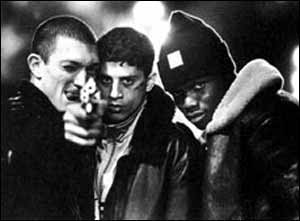


We then see Vinz sitting at a dining table with his sister, aunt and grandmother while Saïd joins them. After some nagging from Saïd, Vinz rolls out of bed and briefly chats with his young friend.

Saïd enters the apartment and walks into Vinz’s bedroom, where the latter is found facedown in his bed, drooling as he sleeps. “La Haine” is set the morning after a riot raged the previous night between youths and police in a Paris suburb as a response to the brutal beating that a North African teenager named Abdel Ichaha received from the police, leaving him hospitalized and in a coma, an obvious parallel to M’Bowole’s murder.Īfter the film begins with an opening montage of various real-life riots raging throughout the streets of Paris set to Bob Marley’s “Burnin’ and Lootin’”, we see footage of a teenager (Saïd) sneaking past a line of menacing-looking officers standing outside of a police station as he approaches one of their vehicles and writes “F*** THE POLICE!” on it in French with a permanent marker before scurrying away to the apartment of his friend Vinz.Īfter a humorous shouting match ensues outside of an apartment building between Saïd, who’s down on the ground, Vinz’s sister from up above in her apartment window and an older man tells the two to shut up from his window in another building. M’Bowole’s shooting death was later ruled as an accident. Following the news of the shooting, violent clashes occurred the next day between officers and protestors who took to the streets to condemn racism and police brutality. M’Bowole was accused of shoplifting and was reportedly handcuffed to a radiator when he was shot at point-blank range by a police officer. Kassovitz’s inspiration for “La Haine” was the Apincident in which a 16-year-old Zairian immigrant in Paris named Makome M’Bowole was killed while in police custody. In a curious inverse to many of the housing projects located in the United States, France’s poor are left to rot on the literal margins of a city, whereas America’s poor and disenfranchised dwell within urban areas while those who can afford to do so populate the suburbs. Each of the young men live in a vast housing project called the Muguet, constructed miles away from Paris’ five-star restaurants and looming Eiffel Tower in a banlieue (suburb). “La Haine” centers around a day in the life of Hubert, Saïd and Vinz-three youths somewhere between the ages of 16-20.


 0 kommentar(er)
0 kommentar(er)
